Nursing Care: Infant Abdominal Pain, Pathophysiology, and Treatment
VerifiedAdded on 2023/06/07
|9
|2326
|300
Report
AI Summary
This nursing report details the care of an infant, Jay, experiencing abdominal pain. It begins with an introduction and a description of the pathophysiology, suggesting possible causes like digestive issues or intussusception. The report emphasizes the nurse's role in assessment, including evaluating the infant's condition, considering growth and developmental theories, and implementing family-centered care. The assessment includes evaluating the child's airway, breathing, and fluid status. The report also discusses the effects of hospitalization on the child and stresses the importance of the nurse's patience, efficiency, and knowledge in providing effective care. The case study highlights the symptoms of vomiting, reduced feeding, and spasmodic abdominal pain, leading to a diagnosis of intussusception. The report stresses the importance of proper assessment, diagnosis, and the implementation of nursing care based on the doctor's guidance, including the use of ultrasound and air enema. The report concludes by emphasizing the need for nurses to follow guidelines, provide proper medication, and prioritize the infant's and family's needs to ensure successful recovery.
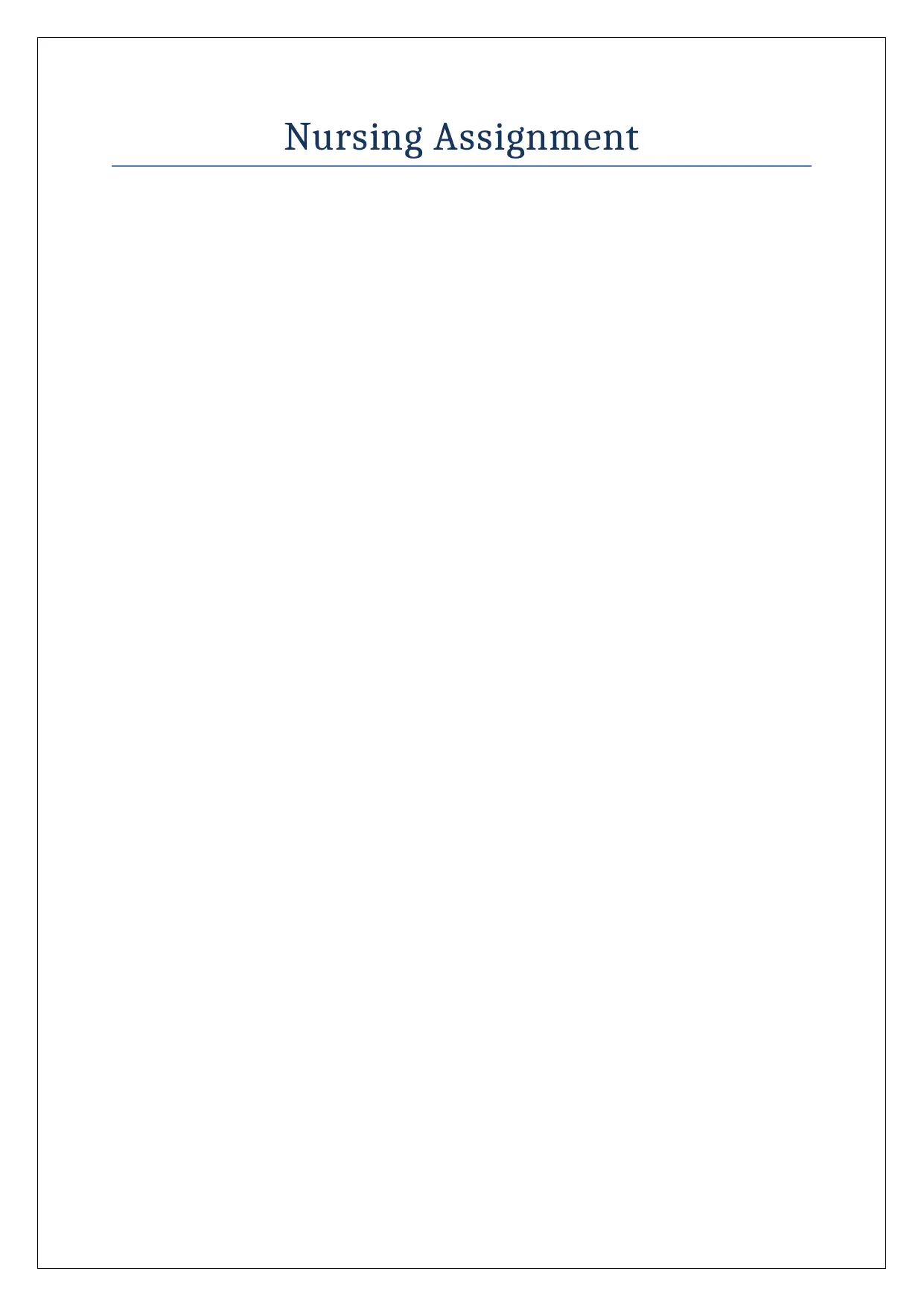
Nursing Assignment
Paraphrase This Document
Need a fresh take? Get an instant paraphrase of this document with our AI Paraphraser
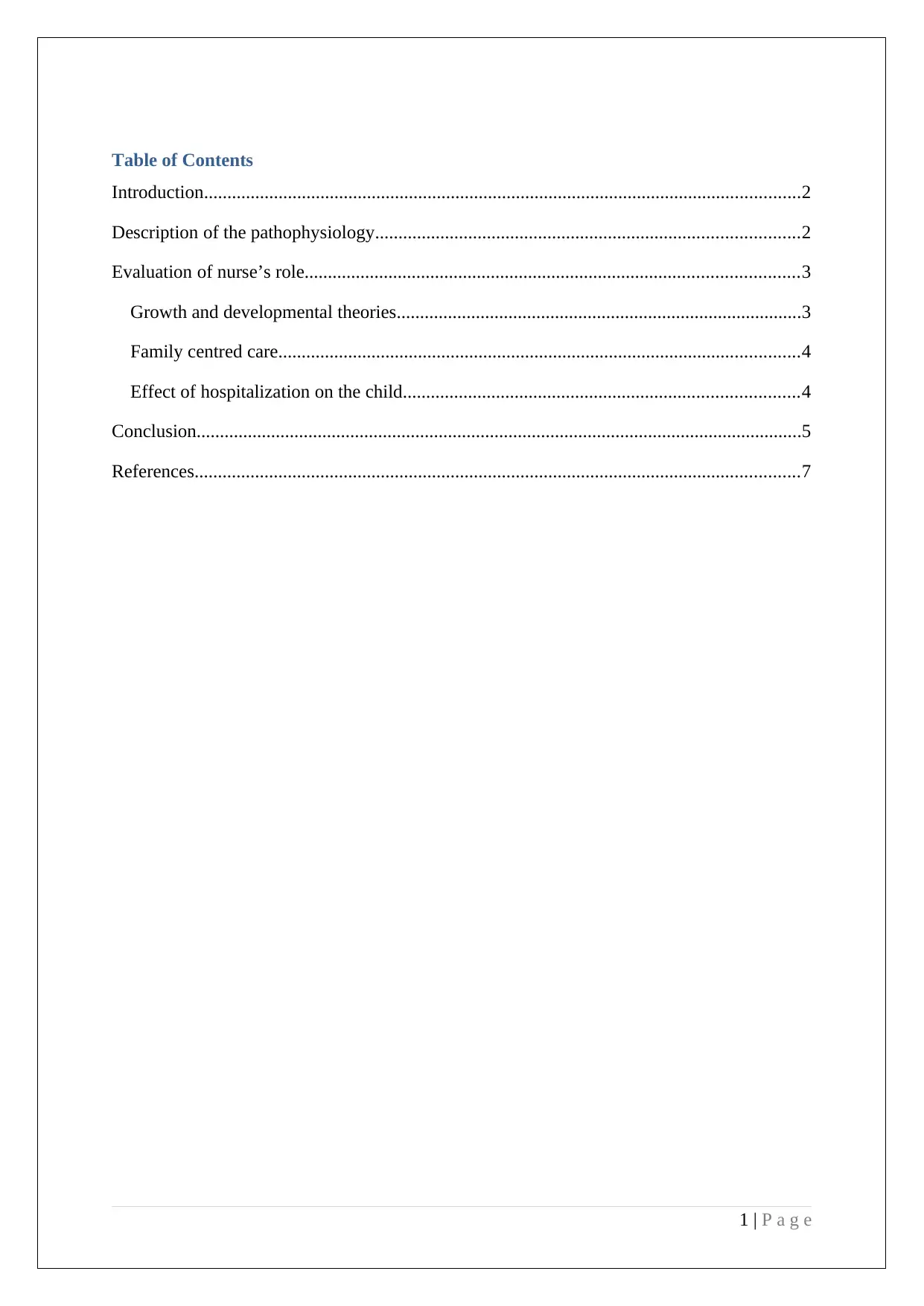
Table of Contents
Introduction................................................................................................................................2
Description of the pathophysiology...........................................................................................2
Evaluation of nurse’s role..........................................................................................................3
Growth and developmental theories.......................................................................................3
Family centred care................................................................................................................4
Effect of hospitalization on the child.....................................................................................4
Conclusion..................................................................................................................................5
References..................................................................................................................................7
1 | P a g e
Introduction................................................................................................................................2
Description of the pathophysiology...........................................................................................2
Evaluation of nurse’s role..........................................................................................................3
Growth and developmental theories.......................................................................................3
Family centred care................................................................................................................4
Effect of hospitalization on the child.....................................................................................4
Conclusion..................................................................................................................................5
References..................................................................................................................................7
1 | P a g e
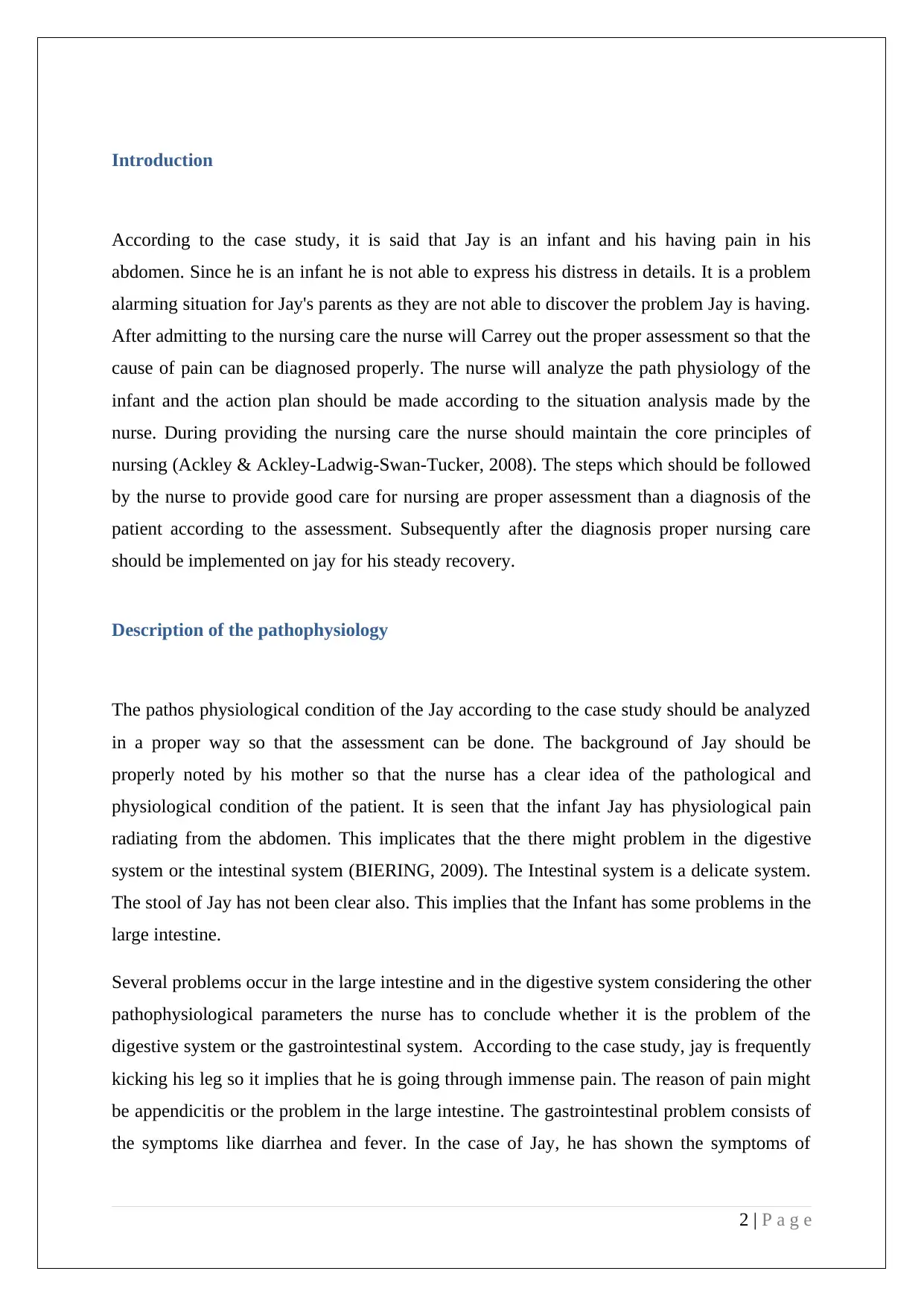
Introduction
According to the case study, it is said that Jay is an infant and his having pain in his
abdomen. Since he is an infant he is not able to express his distress in details. It is a problem
alarming situation for Jay's parents as they are not able to discover the problem Jay is having.
After admitting to the nursing care the nurse will Carrey out the proper assessment so that the
cause of pain can be diagnosed properly. The nurse will analyze the path physiology of the
infant and the action plan should be made according to the situation analysis made by the
nurse. During providing the nursing care the nurse should maintain the core principles of
nursing (Ackley & Ackley-Ladwig-Swan-Tucker, 2008). The steps which should be followed
by the nurse to provide good care for nursing are proper assessment than a diagnosis of the
patient according to the assessment. Subsequently after the diagnosis proper nursing care
should be implemented on jay for his steady recovery.
Description of the pathophysiology
The pathos physiological condition of the Jay according to the case study should be analyzed
in a proper way so that the assessment can be done. The background of Jay should be
properly noted by his mother so that the nurse has a clear idea of the pathological and
physiological condition of the patient. It is seen that the infant Jay has physiological pain
radiating from the abdomen. This implicates that the there might problem in the digestive
system or the intestinal system (BIERING, 2009). The Intestinal system is a delicate system.
The stool of Jay has not been clear also. This implies that the Infant has some problems in the
large intestine.
Several problems occur in the large intestine and in the digestive system considering the other
pathophysiological parameters the nurse has to conclude whether it is the problem of the
digestive system or the gastrointestinal system. According to the case study, jay is frequently
kicking his leg so it implies that he is going through immense pain. The reason of pain might
be appendicitis or the problem in the large intestine. The gastrointestinal problem consists of
the symptoms like diarrhea and fever. In the case of Jay, he has shown the symptoms of
2 | P a g e
According to the case study, it is said that Jay is an infant and his having pain in his
abdomen. Since he is an infant he is not able to express his distress in details. It is a problem
alarming situation for Jay's parents as they are not able to discover the problem Jay is having.
After admitting to the nursing care the nurse will Carrey out the proper assessment so that the
cause of pain can be diagnosed properly. The nurse will analyze the path physiology of the
infant and the action plan should be made according to the situation analysis made by the
nurse. During providing the nursing care the nurse should maintain the core principles of
nursing (Ackley & Ackley-Ladwig-Swan-Tucker, 2008). The steps which should be followed
by the nurse to provide good care for nursing are proper assessment than a diagnosis of the
patient according to the assessment. Subsequently after the diagnosis proper nursing care
should be implemented on jay for his steady recovery.
Description of the pathophysiology
The pathos physiological condition of the Jay according to the case study should be analyzed
in a proper way so that the assessment can be done. The background of Jay should be
properly noted by his mother so that the nurse has a clear idea of the pathological and
physiological condition of the patient. It is seen that the infant Jay has physiological pain
radiating from the abdomen. This implicates that the there might problem in the digestive
system or the intestinal system (BIERING, 2009). The Intestinal system is a delicate system.
The stool of Jay has not been clear also. This implies that the Infant has some problems in the
large intestine.
Several problems occur in the large intestine and in the digestive system considering the other
pathophysiological parameters the nurse has to conclude whether it is the problem of the
digestive system or the gastrointestinal system. According to the case study, jay is frequently
kicking his leg so it implies that he is going through immense pain. The reason of pain might
be appendicitis or the problem in the large intestine. The gastrointestinal problem consists of
the symptoms like diarrhea and fever. In the case of Jay, he has shown the symptoms of
2 | P a g e
⊘ This is a preview!⊘
Do you want full access?
Subscribe today to unlock all pages.

Trusted by 1+ million students worldwide
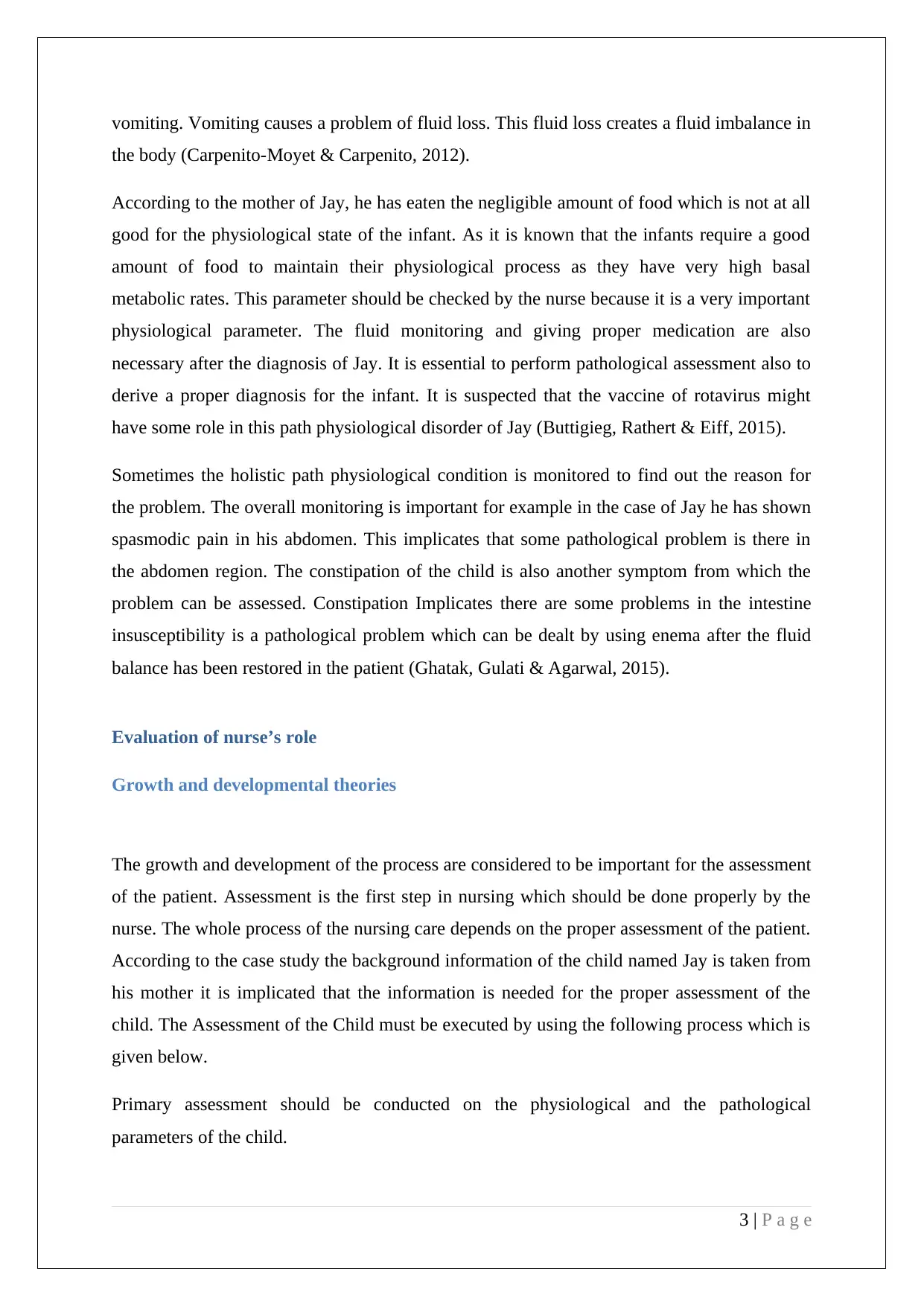
vomiting. Vomiting causes a problem of fluid loss. This fluid loss creates a fluid imbalance in
the body (Carpenito-Moyet & Carpenito, 2012).
According to the mother of Jay, he has eaten the negligible amount of food which is not at all
good for the physiological state of the infant. As it is known that the infants require a good
amount of food to maintain their physiological process as they have very high basal
metabolic rates. This parameter should be checked by the nurse because it is a very important
physiological parameter. The fluid monitoring and giving proper medication are also
necessary after the diagnosis of Jay. It is essential to perform pathological assessment also to
derive a proper diagnosis for the infant. It is suspected that the vaccine of rotavirus might
have some role in this path physiological disorder of Jay (Buttigieg, Rathert & Eiff, 2015).
Sometimes the holistic path physiological condition is monitored to find out the reason for
the problem. The overall monitoring is important for example in the case of Jay he has shown
spasmodic pain in his abdomen. This implicates that some pathological problem is there in
the abdomen region. The constipation of the child is also another symptom from which the
problem can be assessed. Constipation Implicates there are some problems in the intestine
insusceptibility is a pathological problem which can be dealt by using enema after the fluid
balance has been restored in the patient (Ghatak, Gulati & Agarwal, 2015).
Evaluation of nurse’s role
Growth and developmental theories
The growth and development of the process are considered to be important for the assessment
of the patient. Assessment is the first step in nursing which should be done properly by the
nurse. The whole process of the nursing care depends on the proper assessment of the patient.
According to the case study the background information of the child named Jay is taken from
his mother it is implicated that the information is needed for the proper assessment of the
child. The Assessment of the Child must be executed by using the following process which is
given below.
Primary assessment should be conducted on the physiological and the pathological
parameters of the child.
3 | P a g e
the body (Carpenito-Moyet & Carpenito, 2012).
According to the mother of Jay, he has eaten the negligible amount of food which is not at all
good for the physiological state of the infant. As it is known that the infants require a good
amount of food to maintain their physiological process as they have very high basal
metabolic rates. This parameter should be checked by the nurse because it is a very important
physiological parameter. The fluid monitoring and giving proper medication are also
necessary after the diagnosis of Jay. It is essential to perform pathological assessment also to
derive a proper diagnosis for the infant. It is suspected that the vaccine of rotavirus might
have some role in this path physiological disorder of Jay (Buttigieg, Rathert & Eiff, 2015).
Sometimes the holistic path physiological condition is monitored to find out the reason for
the problem. The overall monitoring is important for example in the case of Jay he has shown
spasmodic pain in his abdomen. This implicates that some pathological problem is there in
the abdomen region. The constipation of the child is also another symptom from which the
problem can be assessed. Constipation Implicates there are some problems in the intestine
insusceptibility is a pathological problem which can be dealt by using enema after the fluid
balance has been restored in the patient (Ghatak, Gulati & Agarwal, 2015).
Evaluation of nurse’s role
Growth and developmental theories
The growth and development of the process are considered to be important for the assessment
of the patient. Assessment is the first step in nursing which should be done properly by the
nurse. The whole process of the nursing care depends on the proper assessment of the patient.
According to the case study the background information of the child named Jay is taken from
his mother it is implicated that the information is needed for the proper assessment of the
child. The Assessment of the Child must be executed by using the following process which is
given below.
Primary assessment should be conducted on the physiological and the pathological
parameters of the child.
3 | P a g e
Paraphrase This Document
Need a fresh take? Get an instant paraphrase of this document with our AI Paraphraser
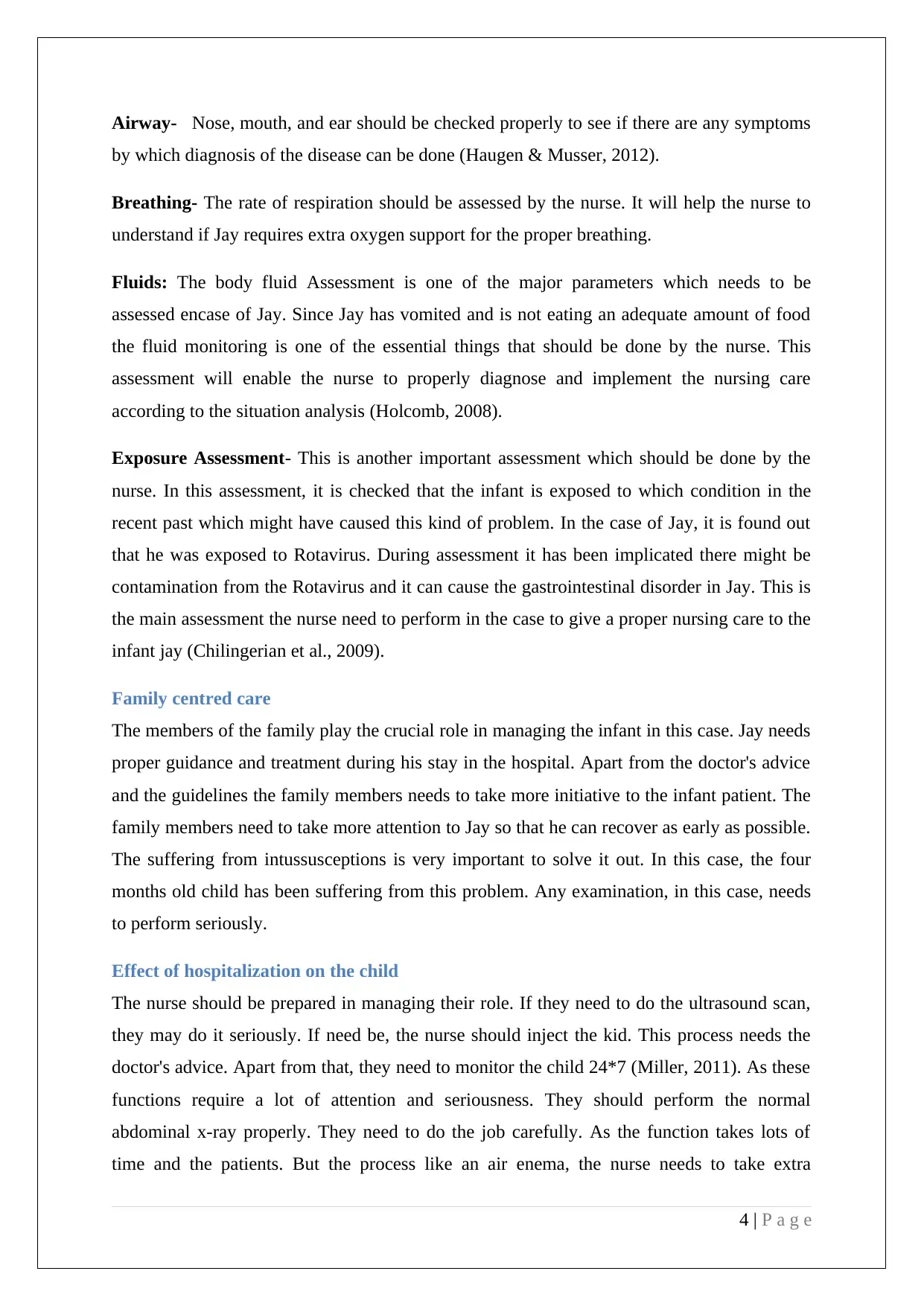
Airway- Nose, mouth, and ear should be checked properly to see if there are any symptoms
by which diagnosis of the disease can be done (Haugen & Musser, 2012).
Breathing- The rate of respiration should be assessed by the nurse. It will help the nurse to
understand if Jay requires extra oxygen support for the proper breathing.
Fluids: The body fluid Assessment is one of the major parameters which needs to be
assessed encase of Jay. Since Jay has vomited and is not eating an adequate amount of food
the fluid monitoring is one of the essential things that should be done by the nurse. This
assessment will enable the nurse to properly diagnose and implement the nursing care
according to the situation analysis (Holcomb, 2008).
Exposure Assessment- This is another important assessment which should be done by the
nurse. In this assessment, it is checked that the infant is exposed to which condition in the
recent past which might have caused this kind of problem. In the case of Jay, it is found out
that he was exposed to Rotavirus. During assessment it has been implicated there might be
contamination from the Rotavirus and it can cause the gastrointestinal disorder in Jay. This is
the main assessment the nurse need to perform in the case to give a proper nursing care to the
infant jay (Chilingerian et al., 2009).
Family centred care
The members of the family play the crucial role in managing the infant in this case. Jay needs
proper guidance and treatment during his stay in the hospital. Apart from the doctor's advice
and the guidelines the family members needs to take more initiative to the infant patient. The
family members need to take more attention to Jay so that he can recover as early as possible.
The suffering from intussusceptions is very important to solve it out. In this case, the four
months old child has been suffering from this problem. Any examination, in this case, needs
to perform seriously.
Effect of hospitalization on the child
The nurse should be prepared in managing their role. If they need to do the ultrasound scan,
they may do it seriously. If need be, the nurse should inject the kid. This process needs the
doctor's advice. Apart from that, they need to monitor the child 24*7 (Miller, 2011). As these
functions require a lot of attention and seriousness. They should perform the normal
abdominal x-ray properly. They need to do the job carefully. As the function takes lots of
time and the patients. But the process like an air enema, the nurse needs to take extra
4 | P a g e
by which diagnosis of the disease can be done (Haugen & Musser, 2012).
Breathing- The rate of respiration should be assessed by the nurse. It will help the nurse to
understand if Jay requires extra oxygen support for the proper breathing.
Fluids: The body fluid Assessment is one of the major parameters which needs to be
assessed encase of Jay. Since Jay has vomited and is not eating an adequate amount of food
the fluid monitoring is one of the essential things that should be done by the nurse. This
assessment will enable the nurse to properly diagnose and implement the nursing care
according to the situation analysis (Holcomb, 2008).
Exposure Assessment- This is another important assessment which should be done by the
nurse. In this assessment, it is checked that the infant is exposed to which condition in the
recent past which might have caused this kind of problem. In the case of Jay, it is found out
that he was exposed to Rotavirus. During assessment it has been implicated there might be
contamination from the Rotavirus and it can cause the gastrointestinal disorder in Jay. This is
the main assessment the nurse need to perform in the case to give a proper nursing care to the
infant jay (Chilingerian et al., 2009).
Family centred care
The members of the family play the crucial role in managing the infant in this case. Jay needs
proper guidance and treatment during his stay in the hospital. Apart from the doctor's advice
and the guidelines the family members needs to take more initiative to the infant patient. The
family members need to take more attention to Jay so that he can recover as early as possible.
The suffering from intussusceptions is very important to solve it out. In this case, the four
months old child has been suffering from this problem. Any examination, in this case, needs
to perform seriously.
Effect of hospitalization on the child
The nurse should be prepared in managing their role. If they need to do the ultrasound scan,
they may do it seriously. If need be, the nurse should inject the kid. This process needs the
doctor's advice. Apart from that, they need to monitor the child 24*7 (Miller, 2011). As these
functions require a lot of attention and seriousness. They should perform the normal
abdominal x-ray properly. They need to do the job carefully. As the function takes lots of
time and the patients. But the process like an air enema, the nurse needs to take extra
4 | P a g e
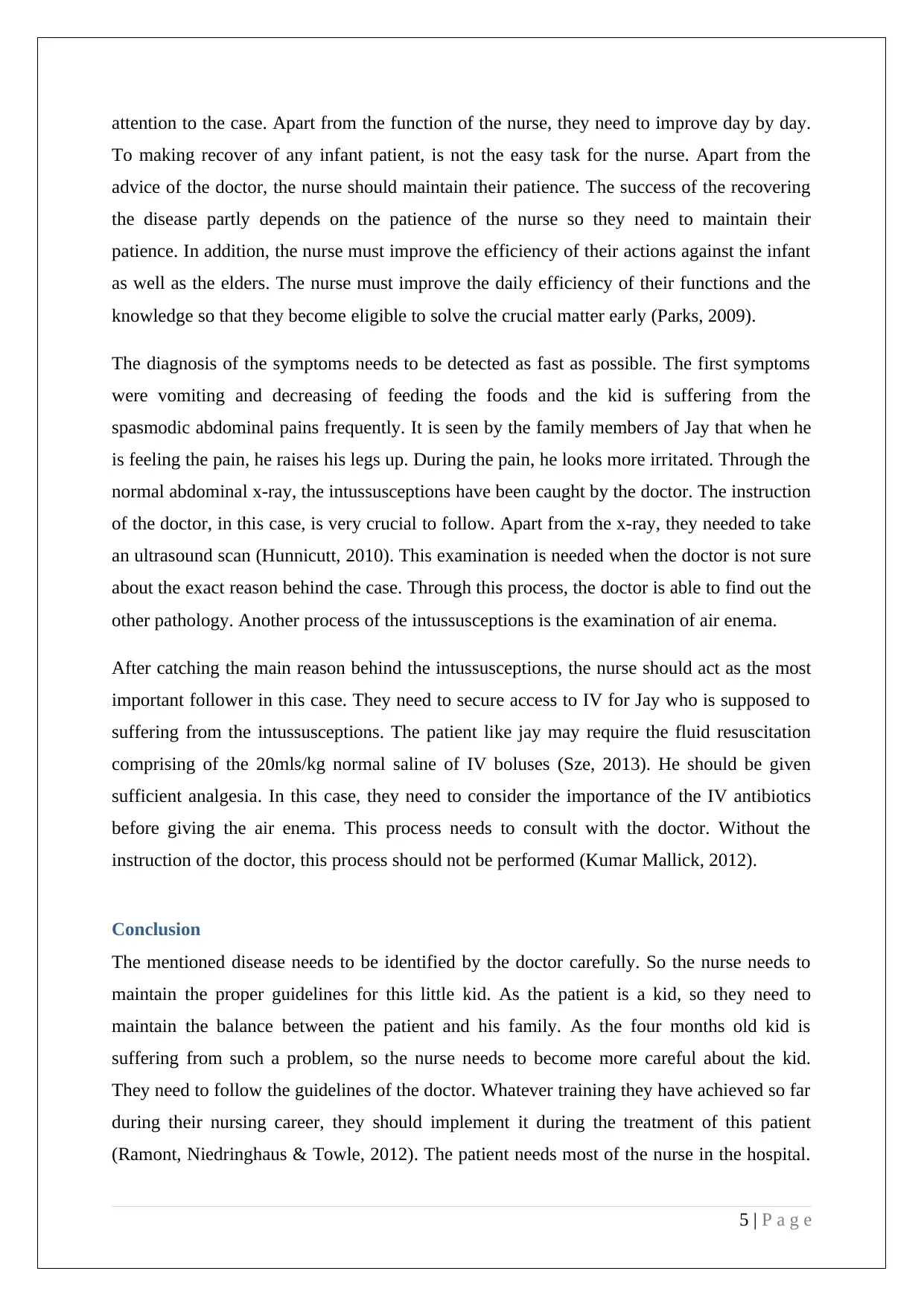
attention to the case. Apart from the function of the nurse, they need to improve day by day.
To making recover of any infant patient, is not the easy task for the nurse. Apart from the
advice of the doctor, the nurse should maintain their patience. The success of the recovering
the disease partly depends on the patience of the nurse so they need to maintain their
patience. In addition, the nurse must improve the efficiency of their actions against the infant
as well as the elders. The nurse must improve the daily efficiency of their functions and the
knowledge so that they become eligible to solve the crucial matter early (Parks, 2009).
The diagnosis of the symptoms needs to be detected as fast as possible. The first symptoms
were vomiting and decreasing of feeding the foods and the kid is suffering from the
spasmodic abdominal pains frequently. It is seen by the family members of Jay that when he
is feeling the pain, he raises his legs up. During the pain, he looks more irritated. Through the
normal abdominal x-ray, the intussusceptions have been caught by the doctor. The instruction
of the doctor, in this case, is very crucial to follow. Apart from the x-ray, they needed to take
an ultrasound scan (Hunnicutt, 2010). This examination is needed when the doctor is not sure
about the exact reason behind the case. Through this process, the doctor is able to find out the
other pathology. Another process of the intussusceptions is the examination of air enema.
After catching the main reason behind the intussusceptions, the nurse should act as the most
important follower in this case. They need to secure access to IV for Jay who is supposed to
suffering from the intussusceptions. The patient like jay may require the fluid resuscitation
comprising of the 20mls/kg normal saline of IV boluses (Sze, 2013). He should be given
sufficient analgesia. In this case, they need to consider the importance of the IV antibiotics
before giving the air enema. This process needs to consult with the doctor. Without the
instruction of the doctor, this process should not be performed (Kumar Mallick, 2012).
Conclusion
The mentioned disease needs to be identified by the doctor carefully. So the nurse needs to
maintain the proper guidelines for this little kid. As the patient is a kid, so they need to
maintain the balance between the patient and his family. As the four months old kid is
suffering from such a problem, so the nurse needs to become more careful about the kid.
They need to follow the guidelines of the doctor. Whatever training they have achieved so far
during their nursing career, they should implement it during the treatment of this patient
(Ramont, Niedringhaus & Towle, 2012). The patient needs most of the nurse in the hospital.
5 | P a g e
To making recover of any infant patient, is not the easy task for the nurse. Apart from the
advice of the doctor, the nurse should maintain their patience. The success of the recovering
the disease partly depends on the patience of the nurse so they need to maintain their
patience. In addition, the nurse must improve the efficiency of their actions against the infant
as well as the elders. The nurse must improve the daily efficiency of their functions and the
knowledge so that they become eligible to solve the crucial matter early (Parks, 2009).
The diagnosis of the symptoms needs to be detected as fast as possible. The first symptoms
were vomiting and decreasing of feeding the foods and the kid is suffering from the
spasmodic abdominal pains frequently. It is seen by the family members of Jay that when he
is feeling the pain, he raises his legs up. During the pain, he looks more irritated. Through the
normal abdominal x-ray, the intussusceptions have been caught by the doctor. The instruction
of the doctor, in this case, is very crucial to follow. Apart from the x-ray, they needed to take
an ultrasound scan (Hunnicutt, 2010). This examination is needed when the doctor is not sure
about the exact reason behind the case. Through this process, the doctor is able to find out the
other pathology. Another process of the intussusceptions is the examination of air enema.
After catching the main reason behind the intussusceptions, the nurse should act as the most
important follower in this case. They need to secure access to IV for Jay who is supposed to
suffering from the intussusceptions. The patient like jay may require the fluid resuscitation
comprising of the 20mls/kg normal saline of IV boluses (Sze, 2013). He should be given
sufficient analgesia. In this case, they need to consider the importance of the IV antibiotics
before giving the air enema. This process needs to consult with the doctor. Without the
instruction of the doctor, this process should not be performed (Kumar Mallick, 2012).
Conclusion
The mentioned disease needs to be identified by the doctor carefully. So the nurse needs to
maintain the proper guidelines for this little kid. As the patient is a kid, so they need to
maintain the balance between the patient and his family. As the four months old kid is
suffering from such a problem, so the nurse needs to become more careful about the kid.
They need to follow the guidelines of the doctor. Whatever training they have achieved so far
during their nursing career, they should implement it during the treatment of this patient
(Ramont, Niedringhaus & Towle, 2012). The patient needs most of the nurse in the hospital.
5 | P a g e
⊘ This is a preview!⊘
Do you want full access?
Subscribe today to unlock all pages.

Trusted by 1+ million students worldwide

They should provide proper medicine to Jay. If they need any matter which is related to Jay's
treatment urgent, they must arrange and give the proper satisfaction of the kid like Jay. If
every instruction of the doctor is followed by the nurse, then Jay’s health problem will soon
be solved.
6 | P a g e
treatment urgent, they must arrange and give the proper satisfaction of the kid like Jay. If
every instruction of the doctor is followed by the nurse, then Jay’s health problem will soon
be solved.
6 | P a g e
Paraphrase This Document
Need a fresh take? Get an instant paraphrase of this document with our AI Paraphraser
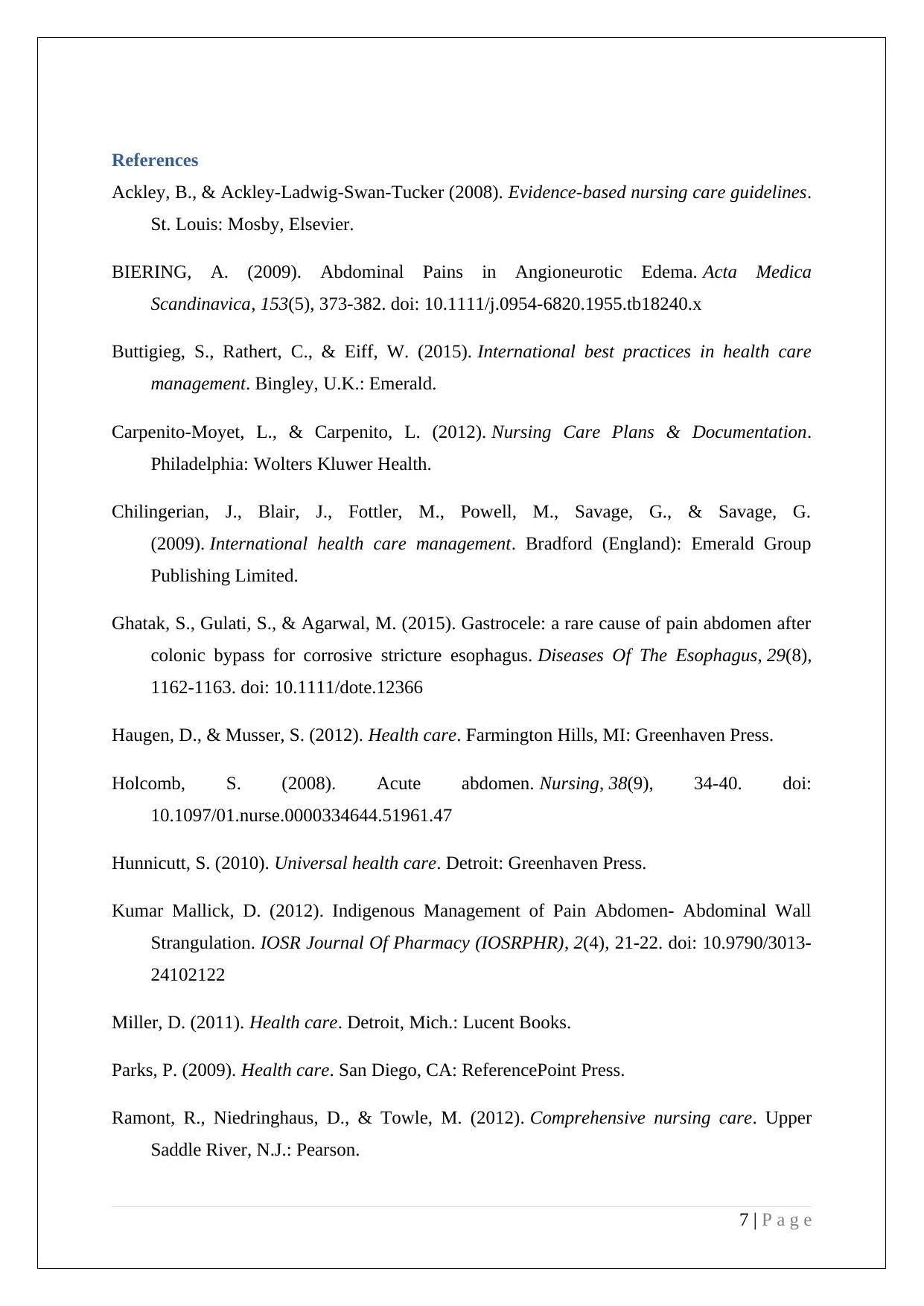
References
Ackley, B., & Ackley-Ladwig-Swan-Tucker (2008). Evidence-based nursing care guidelines.
St. Louis: Mosby, Elsevier.
BIERING, A. (2009). Abdominal Pains in Angioneurotic Edema. Acta Medica
Scandinavica, 153(5), 373-382. doi: 10.1111/j.0954-6820.1955.tb18240.x
Buttigieg, S., Rathert, C., & Eiff, W. (2015). International best practices in health care
management. Bingley, U.K.: Emerald.
Carpenito-Moyet, L., & Carpenito, L. (2012). Nursing Care Plans & Documentation.
Philadelphia: Wolters Kluwer Health.
Chilingerian, J., Blair, J., Fottler, M., Powell, M., Savage, G., & Savage, G.
(2009). International health care management. Bradford (England): Emerald Group
Publishing Limited.
Ghatak, S., Gulati, S., & Agarwal, M. (2015). Gastrocele: a rare cause of pain abdomen after
colonic bypass for corrosive stricture esophagus. Diseases Of The Esophagus, 29(8),
1162-1163. doi: 10.1111/dote.12366
Haugen, D., & Musser, S. (2012). Health care. Farmington Hills, MI: Greenhaven Press.
Holcomb, S. (2008). Acute abdomen. Nursing, 38(9), 34-40. doi:
10.1097/01.nurse.0000334644.51961.47
Hunnicutt, S. (2010). Universal health care. Detroit: Greenhaven Press.
Kumar Mallick, D. (2012). Indigenous Management of Pain Abdomen- Abdominal Wall
Strangulation. IOSR Journal Of Pharmacy (IOSRPHR), 2(4), 21-22. doi: 10.9790/3013-
24102122
Miller, D. (2011). Health care. Detroit, Mich.: Lucent Books.
Parks, P. (2009). Health care. San Diego, CA: ReferencePoint Press.
Ramont, R., Niedringhaus, D., & Towle, M. (2012). Comprehensive nursing care. Upper
Saddle River, N.J.: Pearson.
7 | P a g e
Ackley, B., & Ackley-Ladwig-Swan-Tucker (2008). Evidence-based nursing care guidelines.
St. Louis: Mosby, Elsevier.
BIERING, A. (2009). Abdominal Pains in Angioneurotic Edema. Acta Medica
Scandinavica, 153(5), 373-382. doi: 10.1111/j.0954-6820.1955.tb18240.x
Buttigieg, S., Rathert, C., & Eiff, W. (2015). International best practices in health care
management. Bingley, U.K.: Emerald.
Carpenito-Moyet, L., & Carpenito, L. (2012). Nursing Care Plans & Documentation.
Philadelphia: Wolters Kluwer Health.
Chilingerian, J., Blair, J., Fottler, M., Powell, M., Savage, G., & Savage, G.
(2009). International health care management. Bradford (England): Emerald Group
Publishing Limited.
Ghatak, S., Gulati, S., & Agarwal, M. (2015). Gastrocele: a rare cause of pain abdomen after
colonic bypass for corrosive stricture esophagus. Diseases Of The Esophagus, 29(8),
1162-1163. doi: 10.1111/dote.12366
Haugen, D., & Musser, S. (2012). Health care. Farmington Hills, MI: Greenhaven Press.
Holcomb, S. (2008). Acute abdomen. Nursing, 38(9), 34-40. doi:
10.1097/01.nurse.0000334644.51961.47
Hunnicutt, S. (2010). Universal health care. Detroit: Greenhaven Press.
Kumar Mallick, D. (2012). Indigenous Management of Pain Abdomen- Abdominal Wall
Strangulation. IOSR Journal Of Pharmacy (IOSRPHR), 2(4), 21-22. doi: 10.9790/3013-
24102122
Miller, D. (2011). Health care. Detroit, Mich.: Lucent Books.
Parks, P. (2009). Health care. San Diego, CA: ReferencePoint Press.
Ramont, R., Niedringhaus, D., & Towle, M. (2012). Comprehensive nursing care. Upper
Saddle River, N.J.: Pearson.
7 | P a g e
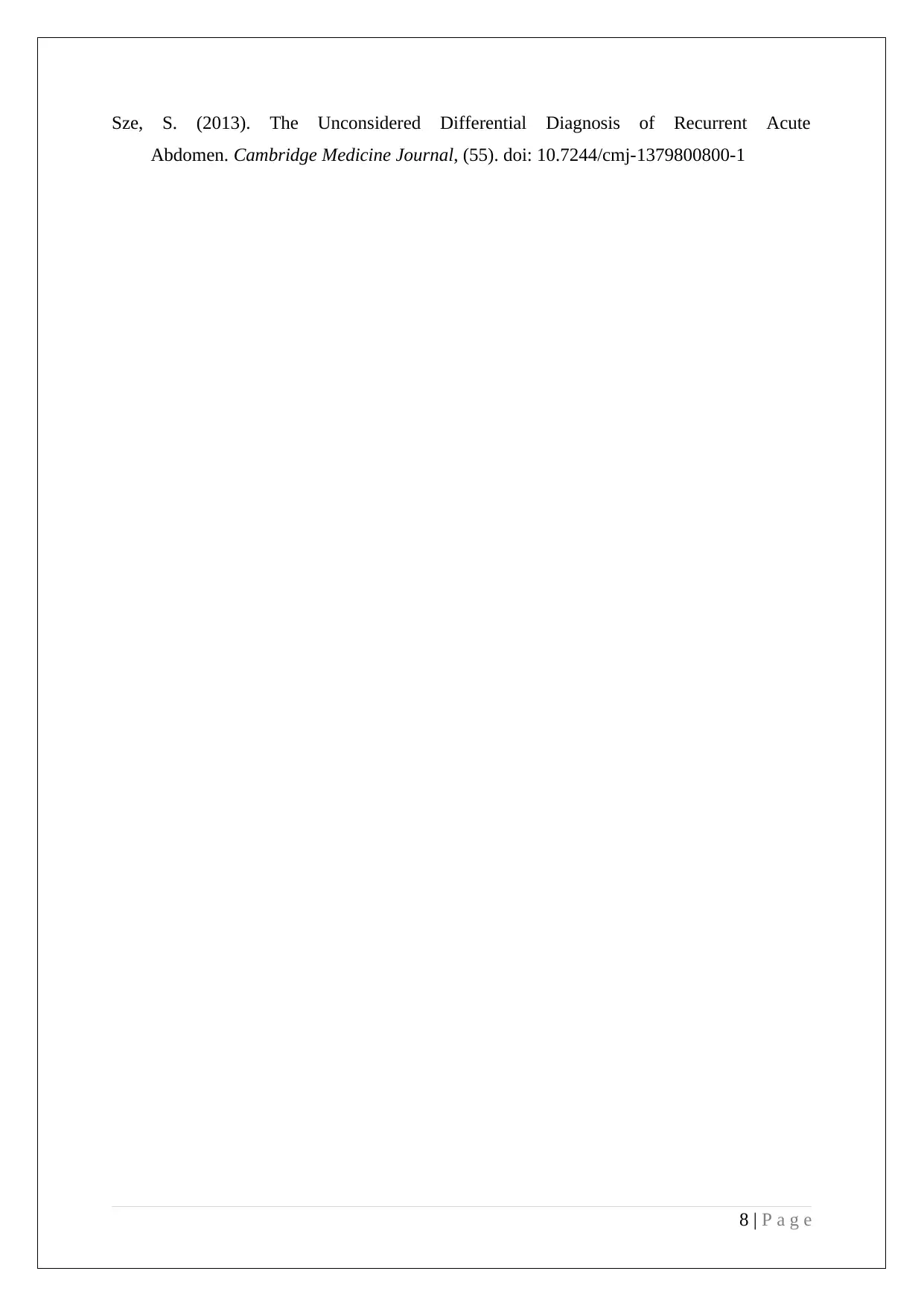
Sze, S. (2013). The Unconsidered Differential Diagnosis of Recurrent Acute
Abdomen. Cambridge Medicine Journal, (55). doi: 10.7244/cmj-1379800800-1
8 | P a g e
Abdomen. Cambridge Medicine Journal, (55). doi: 10.7244/cmj-1379800800-1
8 | P a g e
⊘ This is a preview!⊘
Do you want full access?
Subscribe today to unlock all pages.

Trusted by 1+ million students worldwide
1 out of 9
Related Documents
Your All-in-One AI-Powered Toolkit for Academic Success.
+13062052269
info@desklib.com
Available 24*7 on WhatsApp / Email
![[object Object]](/_next/static/media/star-bottom.7253800d.svg)
Unlock your academic potential
Copyright © 2020–2025 A2Z Services. All Rights Reserved. Developed and managed by ZUCOL.





